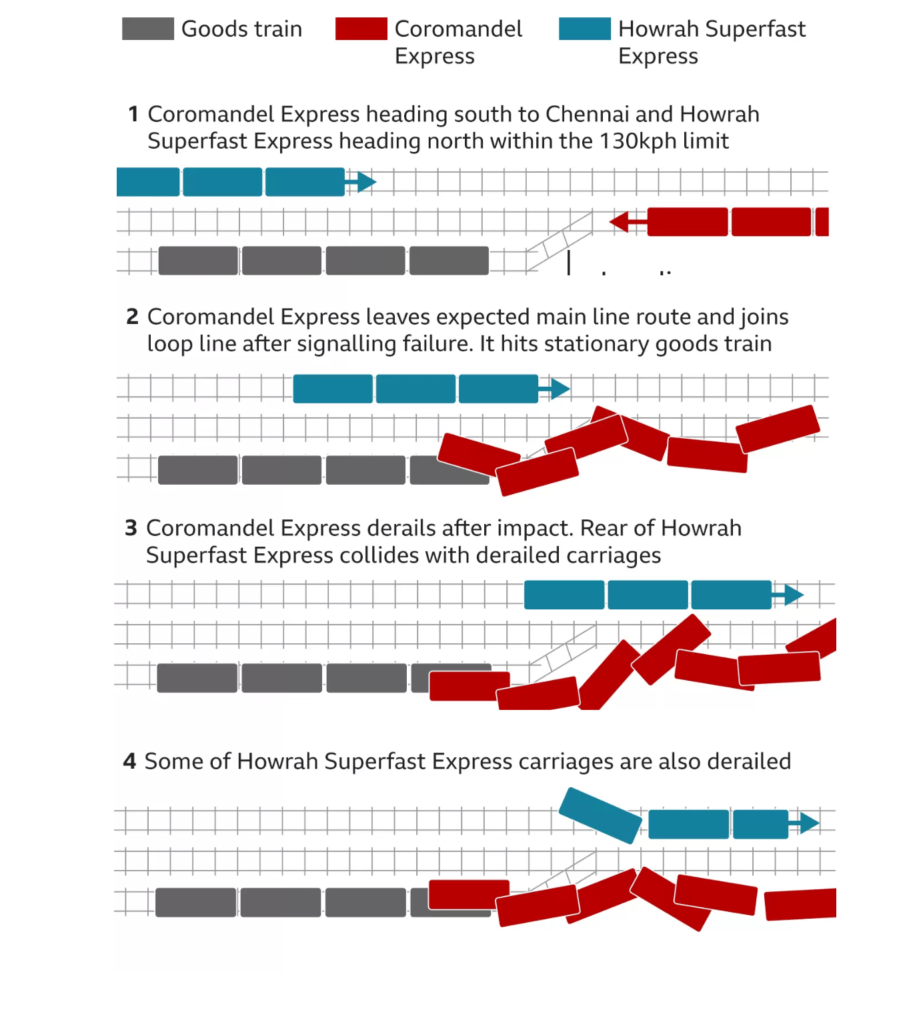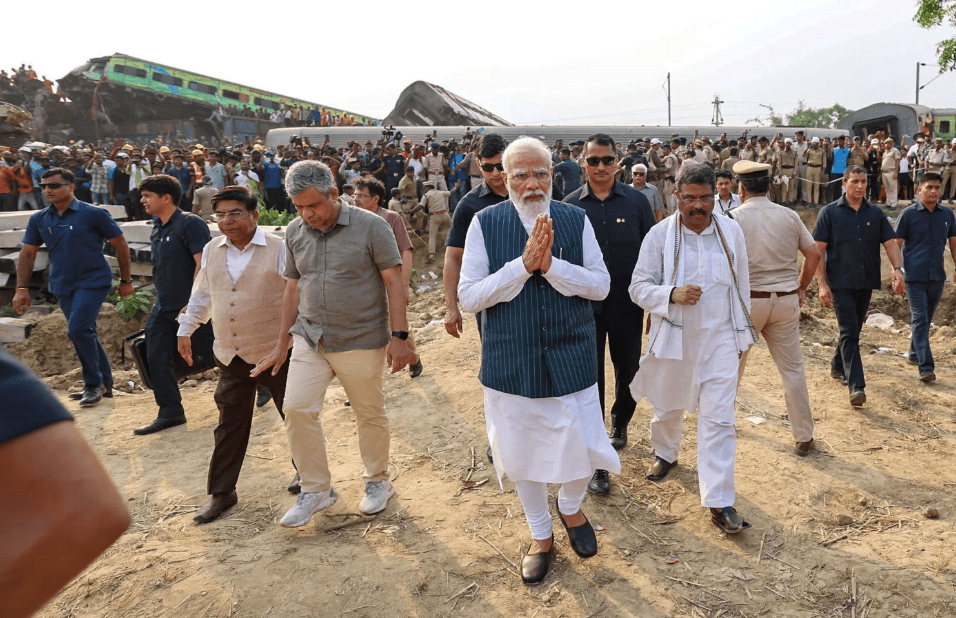
Introduction
The Odisha train accident is an unfortunate incident that can result in significant loss of life, injuries, and damage to property. On Friday, June 2, a passenger train veered off the rails and collided with another one, killing at least 288 people. When they crashed, the passenger trains were traveling at around 130 kph (81 mph). The fast Coromandel Express collided with an iron ore train after switching to a side track off the main track. The Yesvantpur-Howrah Express passenger train was approaching from the other direction when it derailed due to the passenger train’s derailed carriages obstructing another track.
Why do Trains in India go off Track?
- According to sources, a “three-way accident” involving two express passenger trains and a goods train occurred close to a minor station in the eastern state of Odisha. When one of them hit the stopped goods train, one of its carriages toppled over into a third track, derailing an approaching train. According to a preliminary investigation, a signal failure caused the collision.
- One of the world’s largest railway systems, India’s extensive system transports around 25 million people daily across a nationwide network of lines totaling more than 100,000km (62,000 miles). According to Railway Minister Ashwini Vaishnaw, 5,200 km of new rails were installed last year. The minister added that 8,000 kilometers of railways were renovated each year.
- In a recent conversation, Mr. Vaishnaw disclosed that a large portion of the tracks was being upgraded to allow for trains traveling up to 100 km/h, a sizable portion was being enhanced for speeds up to 130 km/h, and a sizable segment was being prepared for the fast speeds of up to 160 km/h.
Also Read: Manipur Violence 2023
Cause of Horror Odisha Train Accident That Killed Hundreds
- The horrific crash’s cause, which resulted in more than 800 injuries and over 300 fatalities, has been identified.
- According to authorities, the derailment of the trains, which happened on Friday night, was brought on by an error in the computerized signaling system that allowed a train to mistakenly change tracks and collide with a goods train.
- If the fault was technological or human-made, a thorough inquiry will show, according to a train official. According to Jaya Verma Sinha, a rail official, the system is 99.9% error-free. However, errors always have a 0.1% probability of occurring.
- When asked if the accident may have been the result of sabotage, she said, “Nothing is ruled out.”
- According to Pradeep Jena, chief secretary of the eastern state of Odisha, the official death toll was reduced from 288 when it was discovered that several remains had been tallied more than once.
An Indian Rail Official Claims a Signaling System Fault Caused the Disaster
- To ensure the safe movement of trains along the track, the electronic interlocking system in railway signaling establishes routes for each train in a specific region.
- Officials claim that the derailment and accident in India on Friday that left 275 people dead and hundreds more wounded was caused by a mistake in an electronic railway signaling system.
- According to investigations, the signal system led to an improper track change made by a passenger train, which led to a collision with a goods train.
- Officials were unsure as of yet whether the signal issue was due to human or technological fault. None of the concerned trains, according to them, were speeding.
- Over 300 individuals have died as a result of the catastrophe, according to a state official who requested anonymity. Later on Sunday, a government announcement from Odisha stated that 275 persons perished in the collision.
How did Three Trains Collide?
Here are the blueprints of how these three Indian trains collided in an Odisha Train Accident

Modi Promises Retribution for the Fatal Odisha Train Accident
- The country’s Prime Minister, Narendra Modi, has stated that anybody found responsible for a tragic rail disaster in eastern India will face “severe punishment.”
- The incident on Friday involving two passenger trains and a cargo train in Odisha state resulted in at least 288 fatalities and more than 800 injuries.
- Mr. Modi visited the location and described the occurrence as “painful”.Additionally, he visited hospitalized catastrophe victims and stated that his administration will do all possible to treat the afflicted.
- The reason for the multiple-train crash in Balasore district, which has been dubbed India’s worst rail tragedy of the century, is yet unknown.
- Although a thorough investigation has been started, according to a preliminary report, by the South Eastern Railway’s head public relations officer, KS Anand, the disaster was caused by a signal failure.

How Does the Interlocking System Ensure Safety in Rail Operations?
By coordinating and managing train movements as well as the functioning of track switches and signals, the interlocking system is an essential part of railway operations that maintains safety.
- Train Movement Control: The interlocking system keeps track of and regulates train movement, prohibiting incompatible movements and providing safe separations between trains. Preventing two trains from using the same piece of track at once, reduces the possibility of crashes.
- Track Switching: Trains can be diverted from one track to another using track switches, which are managed by the interlocking system. It checks that switches are correctly positioned before allowing a train to pass, eliminating derailments or accidents brought on by misaligned switches.
- Signal Control: Signals are controlled by the interlocking system, which gives train operators visual cues regarding the condition of the track in front of them. Important information is communicated through signals, including whether the track is clear, whether the train should continue or stop, and the maximum speed that the train may move. The interlocking system makes sure that trains react appropriately and that signals display the necessary information.
- Safety Interlocks: Safety interlocks are included in the interlocking system to stop dangerous situations. These interlocks stop incompatible actions from occurring, such as stopping a signal from showing a “clear” indication if the track ahead is not clear. Additionally, they guarantee that trains cannot travel through switches that are being replaced, lowering the possibility of derailments or accidents brought on by improper switch movements.
- Centralized Control: The interlocking system is frequently centrally managed by a centralized control center in bigger railway networks. This enables greater network-wide coordination and oversight of train movements, switches, and signals. By providing real-time monitoring, quick reaction to accidents, and the capacity to override manual controls when necessary, centralized control improves safety.
Conclusion
The frequency of train incidents in India emphasizes the necessity of ongoing efforts to improve safety protocols in railway operations. The goal should be to avoid accidents and protect the safety of passengers and railway employees by fixing infrastructural problems, introducing cutting-edge technology, offering thorough training, and fostering a culture of safety. The Indian railway system must be dedicated to strict safety standards and continuous development if it is to develop into a safer and more dependable form of transportation.
Frequently Asked Questions (FAQs)
What was the fault of the Balasore accident?
According to the study sent to the Railway Minister and Railway Board, the triple-train crash on June 2 was caused by errors in the signaling circuit modification work done at the Bahanaga Bazaar station, which led to the erroneous signal being given to the Coromandel Express.
What is the root cause of the Odisha train accident?
Odisha railway disaster – People, accident, and their causes…
“The commissioner of railway safety has looked into the case and has allowed the investigation report to be released, but we have determined the incident’s cause and its perpetrators… A modification to electrical interlocking was the cause of it.Who is responsible for the Balasore train accident?
The investigation agency detained Senior Section Engineer (Signal) Mohammed Amir Khan based in Soro near Balasore, Senior Section Engineer (Signal) Arun Kumar Mahanta and technician Pappu Kumar posted in Balasore.
What is the investigation of the Balasore train accident?
At least 291 people were killed in a triple train collision in Balasore, Odisha, on June 2; the Central Bureau of Investigation (CBI) detained two senior section engineers (signal) and a technician on July 7 on charges of culpable homicide not amounting to murder and destruction of evidence.
Sources:
- 2023 Odisha train collision – Wikipedia
- Odisha: Odisha 2023: Triple train accident, Pandian’s meteoric rise hog limelight – The Economic Times (indiatimes.com)
- Odisha train crash: Key takeaways from preliminary reports to gutwrenching survivor stories- The New Indian Express
- Railways report on Odisha train tragedy reveals what caused crash | Details – India Today
- Odisha train accident | Government revises death toll down to 275; Railways seeks CBI probe – The Hindu
- What caused the India train accident? Here’s what we know about the crash. – The Washington Post
